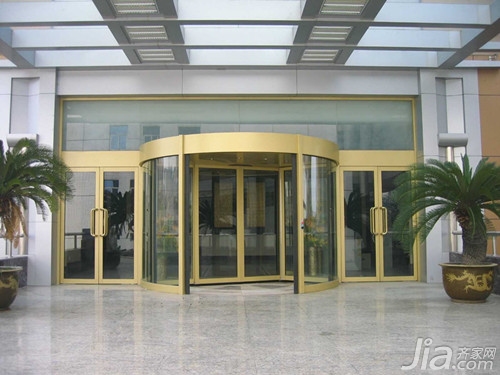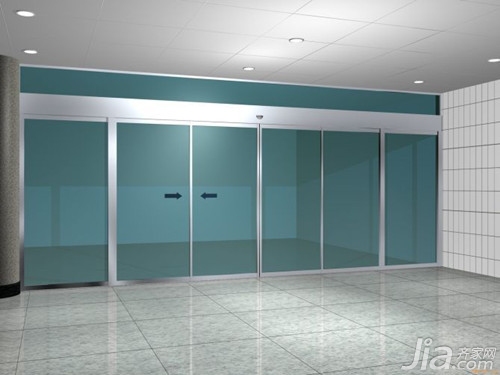Induction doors are commonly referred to as electric, electronic, or glass induction doors. But do these different types of induction doors operate on the same principle? Is there a unified algorithm for their pricing? Or do they each have unique starting and sensing mechanisms based on their design? In this article, we will explore the working principles of electric induction doors, electronic induction door quotations, and how glass induction doors function.

Working Principle of Electronic Induction Doors
When an induction sensor detects someone approaching, it sends a pulse signal to the main controller. The controller then processes this information and instructs the motor to start running. At the same time, it monitors the number of revolutions made by the motor, ensuring it transitions into slow operation at a set time. Once the motor receives the required current, it rotates forward, transferring power through the synchronous belt to the spreading system, which then opens the door leaf. After the door is fully open, the controller assesses the movement and initiates the closing process.

The working mechanism of electric induction doors is similar to that of electronic induction doors, but they use an electric starting method. Electronic induction doors are known for their high level of intelligence and user-friendliness. They incorporate powerful microprocessors and advanced sensing systems, ensuring stable performance and long-term durability. These doors provide convenience through modern technology, offering features like dustproofing and wind resistance, effectively managing foot traffic. When it comes to quotation algorithms, the basic structure is similar across models, though material choices may affect the final cost. For example, the Panasonic induction door pricing model can serve as a reference.

Key Features of Electronic Induction Doors
- Microcomputer-based intelligent control with advanced mechanical design
- Automatically adjusts door operation; manual adjustment available when needed
- Smooth and quiet opening and closing
- Brushless motor for extended service life
- Double-door interlock and electronic lock functions, compatible with multiple access control systems
- Lightweight yet durable, with strong load capacity
- Easy installation and maintenance

Glass Induction Doors
Glass induction doors are named for the type of door leaf used—typically made of glass—but their operation relies on an automatic door opener or other key systems. These doors not only enhance the aesthetics of a space but also provide insulation against temperature changes. You often see them in large supermarkets, hotels, and commercial buildings. While they are widely used in public areas, their application in residential settings remains limited due to higher costs. On average, a glass induction door can cost around 5,000 yuan, making it impractical for home interior doors. However, as living standards improve and prices drop, it's likely that induction doors will become more common in homes in the future.
What, you're still using your own money for decoration? ! The Qi family is offering installment plans with an ultra-low annual interest rate of 3.55% and a maximum loan of 1 million yuan. Apply now and enjoy exclusive discounts.
If you're interested in brand collaborations, content partnerships, or advertising opportunities on this site, please send an email to: [email protected]
Sliding door, glass door price, home decoration, glass door
Material: Indoor ceramic flowerpots are crafted from clay that has been fired at high temperatures, resulting in a sturdy yet porous material. Ceramic pots offer excellent breathability for plant roots and come in a variety of finishes, including glazed or unglazed options.
Size and Shape: These flowerpots come in a diverse range of sizes to accommodate different types of indoor plants, from tiny pots for succulents to larger ones for house trees or ferns. Shapes vary widely, encompassing classic round or cylindrical pots, square or rectangular containers, or more unique shapes like oval, hexagonal, or even abstract designs.
Design and Style: One of the hallmarks of indoor ceramic flowerpots is their aesthetic appeal. They are available in countless designs and styles to complement various interior décor themes. These pots may feature intricate patterns, vibrant colors, minimalist designs, or textured surfaces, adding visual interest to indoor plant displays.
Drainage Holes: Adequate drainage is crucial for the health of indoor plants, so most ceramic flowerpots come with drainage holes at the bottom. This prevents water from pooling at the bottom of the pot, reducing the risk of root rot. Some pots also include saucers to catch excess water and protect indoor surfaces.
Weight: Ceramic flowerpots tend to be heavier than plastic or fiberglass alternatives, providing stability for indoor plants. While this weight offers security, it may also make larger pots more challenging to move around. However, smaller ceramic pots are typically lightweight and manageable.
Maintenance: Indoor ceramic flowerpots require minimal maintenance but benefit from occasional cleaning to remove dust, dirt, or water stains. A gentle wipe with a damp cloth or sponge is usually sufficient. Avoid using abrasive cleaners or harsh chemicals that could damage the glazed surface.
Cost: The cost of indoor ceramic flowerpots varies depending on factors like size, design intricacy, and craftsmanship. While they may be more expensive than plastic or terra cotta pots, their durability, aesthetic appeal, and contribution to indoor décor make them a worthwhile investment for many indoor gardeners.
Overall, indoor ceramic flowerpots blend functionality with beauty, serving as elegant vessels for indoor plants while enhancing the ambiance of any interior space. Their versatility in design and size makes them a popular choice for adding greenery and style to homes, offices, or other indoor environments.
Indoor Ceramic Flower Pot , cultivating plants inside homes, container for house plants
Yixing Bocai Pottery Co.,Ltd , https://www.bocaipottery.com